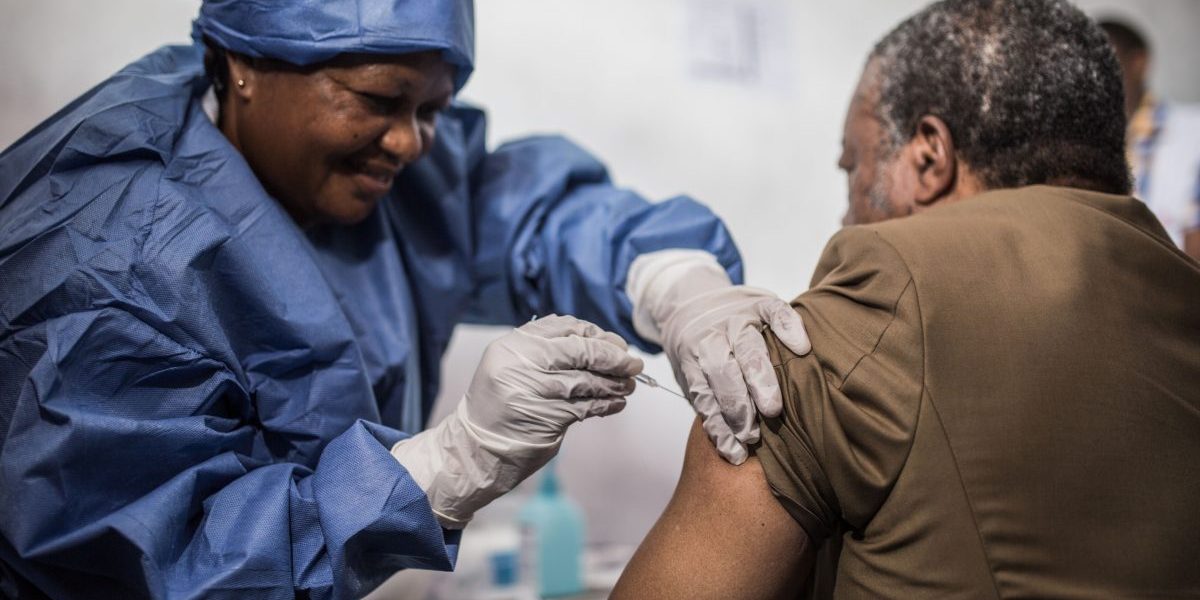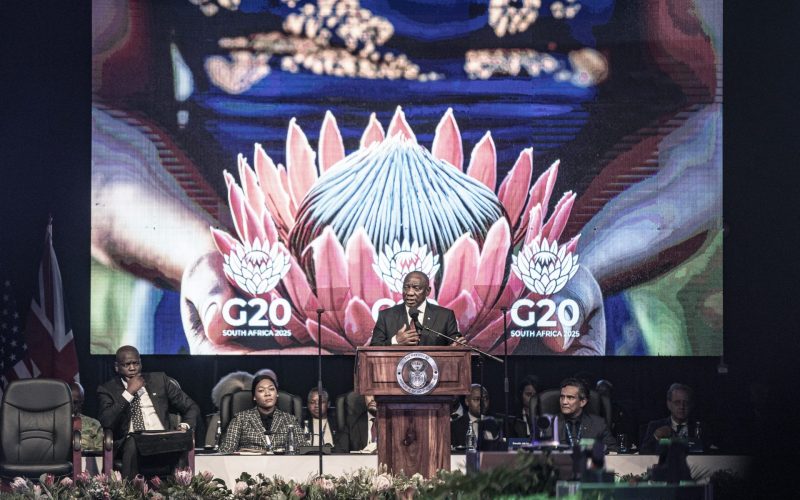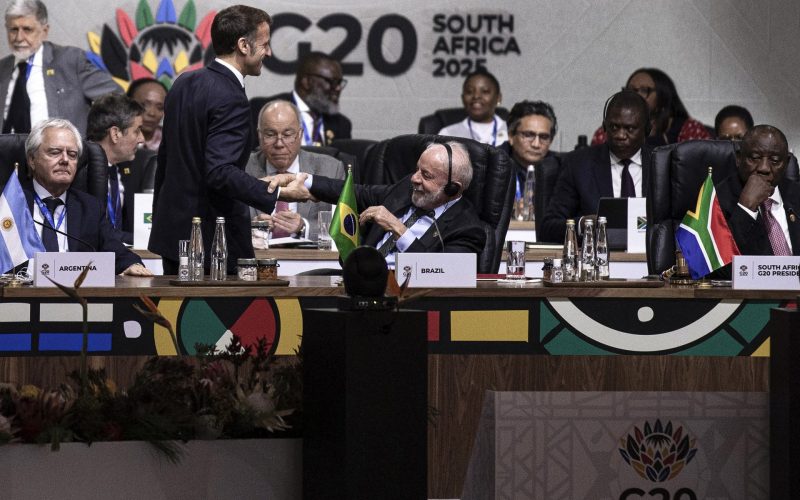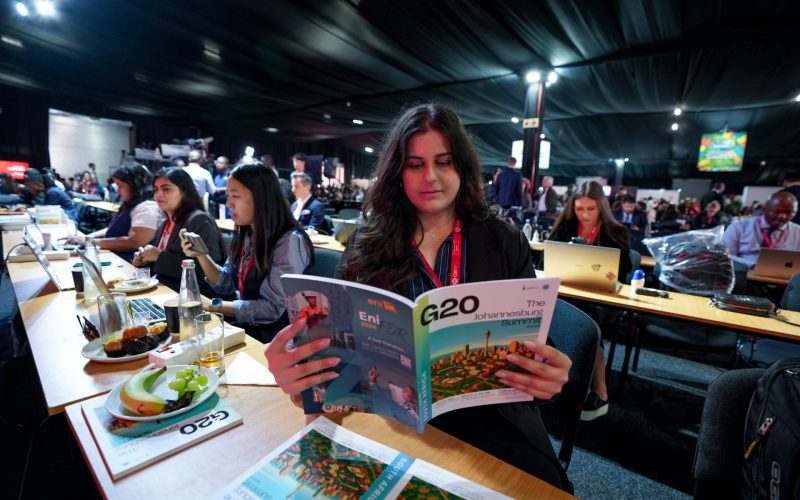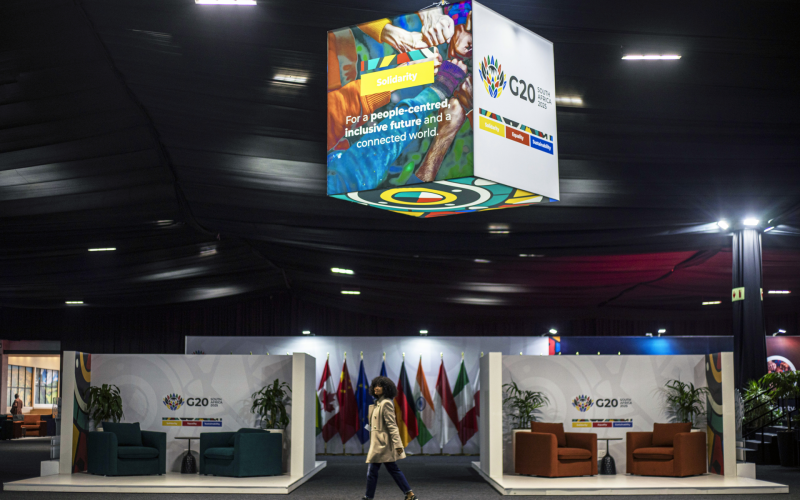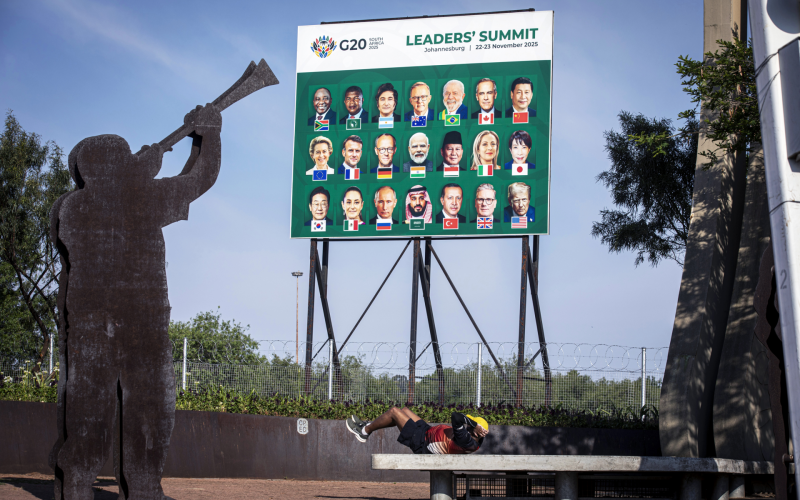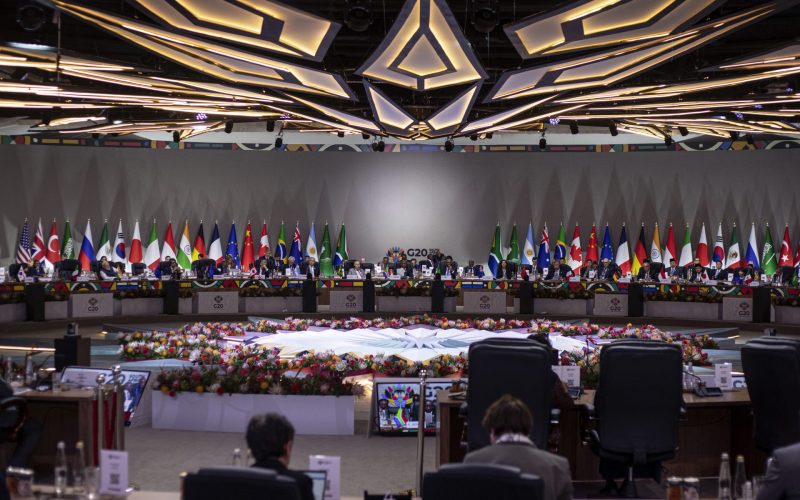Recommendations:
- Italy has taken presidency of the G20 under exceptional circumstances. It will require exceptional leadership to galvanise and guide G20 members to adopt a collective recovery approach and mobilise funds to meet the estimated $28 billion funding gap to finance the Access to COVID-19 Tools Accelerator and its COVAX facility.
- Optimistic forecasts on global distribution estimate the vaccine will take up to 12 months post approval to be available on large scale. The G20’s Debt Service Suspension Initiative should at a minimum align with those time frames.
- Donor assistance and governmental efforts should not be confined to controlling COVID-19 and reinforcing the first line of defence (preparedness), but should equally extend to the second line of defence (strengthening healthcare systems and securing sustainable funding arrangements).
- Donors and governments should avoid zero-sum shifts in resource allocations, instead opting to leverage available funding and adjust programmes to exploit synergies in co-morbidities, adopting a whole systems approach to maximise crossdisease benefits and advancing win-win strategies.
- Donors have the opportunity to leverage the moment, moving away from business as usual and leaning towards streamlining and adopting broad inter-organisational and intertemporally sophisticated approaches to aid, reducing fragmentation and duplication, and maximising cross-disease benefits.
- Domestic resource mobilisation will be the optimal choice to ensure sustainable financing for strengthening healthcare systems. LMIC governments should support healthcare systems’ strengthening within existing budgets, improving efficiency in health spending by opting for best buys and expanding their fiscal space through tax reforms.
- Drawing lessons from past epidemics and pandemics is an important part of strengthening systems. Adopting essential lessons from the AIDS epidemic will accelerate the fight against COVID-19, including lessons around intellectual property.
Executive summary
Low- and middle-income countries (LMICs) ordinarily experience protracted epidemiological transitions – the dual burden of infection and chronic noncommunicable disease (NCD). The COVID-19 pandemic has left LMICs with a triple burden: pre-existent NCDs; infection responses; and a pandemic response financing gap. Addressing the burden will require strategic intervention and more finance. This briefing explores how governments and donors can navigate current global health challenges to adequately respond to the pandemic while sustainably mobilising resources to strengthen global health interventions in the long term.
Introduction
The tide of change
The case for investing in pandemic preparedness after the H1N1, SARS, Ebola and Zika outbreaks was compelling. It engaged the global community and brought into effect key diagnostic mechanisms for pandemic preparedness, such as the World Bank’s Joint External Evaluation, which enables countries to systematically measure critical capacities and identify gaps in preparedness. Yet its output largely translated into ‘ample analysis [and] inadequate action’, with countries demonstrably failing to invest enough in pandemic preparedness.1Suerie Moon et al., “Post-Ebola Reforms: Ample Analysis, Inadequate Action”, British Medical Journal 356, no. 8090 (2017): 1-4.The COVID-19 pandemic has exposed intersectional fault lines in global health security, governance and national healthcare systems. It illustrated that economic wealth and developed infrastructure are not necessarily commensurate with robust pandemic preparedness, with healthcare systems in some high-income countries pushed to near breaking point.2Collet Dandara, Kevin Dzobo and Shadreck Chirikure, “COVID-19 pandemic and Africa: From the situation in Zimbabwe to a case for precision herbal medicine,’ OMICS: A Journal of Integrative Biology 24 (2020): 1–2.Governmental efforts to flatten the COVID-19 curve have steepened the economic recession, the impact of which will be nontrivial for global health and overseas development assistance (ODA) in the months and years ahead, marking an important tide of change for global health and an opportunity to reimagine and strengthen healthcare systems.3Pierre-Olivier Gourinchas, “Flattening the Pandemic and Recession Curves”, chap. 2 in Mitigating the COVID Economic Crisis: Act Fast and Do Whatever 31 (London: CEPR Press, 2020), http://vietstudies.net/kinhte/COVIDEconomicCrisis.pdf#page=38.
The next phase
As transmission intensity and the local epidemiology of the disease change, with some countries poised for a third wave, the main challenge of the next phase of the crisis will be different. Governments and donors need to develop coherency between the types of disaster relief and preservation policy responses that dominated the earlier stages of the pandemic, and the need to shift to recovery policies. At the same time there is a continuing need to address the pandemic as it unfolds, while shoring up and restoring those parts of global healthcare systems that have been heavily impacted by COVID-19 to ensure pre-pandemic efficiency. Moreover, it is important to strengthen healthcare systems to prevent and withstand a resurgence of the pandemic while readying the infrastructure for equitable global vaccine distribution as soon as a vaccine is approved.4Mauricio Cárdenas and Juan José Guzmán Ayala, “Planning a Sustainable Post-Pandemic Recovery in Latin America and the Caribbean” (Policy Document Series 19, UN Development Programme, Latin America and the Caribbean, 2020), https://www.latinamerica.undp.org/content/rblac/en/home/library/crisis_prevention_and_recovery/planeando-una-recuperacion-sostenible-para-lapospandemia-en-ame.html.The panacea is in not circumscribing donor assistance and governmental efforts solely to controlling COVID-19 and the first line of defence (ie, preparedness), but also extending efforts to the second line of defence – strengthening healthcare systems and securing sustainable funding arrangements.5World Bank Group, International Working Group on Financing Preparedness, From Panic and Neglect to Investing in Health Security: Financing Pandemic Preparedness at a National Level (Washington DC: IWGFP, 2017), http://documents.worldbank.org/curated/en/979591495652724770/From-panic-and-neglect-to-investing-in-health-security-financing-pandemic-preparedness-ata-national-level.
Triple the burden
LMICs that ordinarily experience protracted epidemiological transitions – the dual burden of infection and prevalence of chronic NCDs – are now faced with triple the burden due to the pandemic. COVID-19 disrupted healthcare systems and collided with ongoing battles in regions affected by endemic malaria that have been engaged in a decades-long fight against HIV/AIDS and tuberculosis (TB) and an increasing incidence in drug resistance.6Organisation for Economic Co-operation and Development, Strengthening Health Systems During a Pandemic: The Role of Development Finance, (Policy Responses to COVID-19, OECD, Washington DC, 2020), 24. https://www.oecd.org/coronavirus/policyresponses/strengthening-health-systems-during-a-pandemic-the-role-of-development-finance-f762bf1c/.As COVID-19 began to sweep across the globe it made apparent structural weaknesses in global healthcare systems: for instance, 41 African countries had a combined total of fewer than 2 000 ventilators. This at a time when medical supply chains proved to have a limited capacity to meet demand. It caused a scramble for ventilators and other essential medical supplies that brought into effect ‘beggar-cum-sicken-thy-neighbour’ policies. Governments, either explicitly or subtly, moved toward imposing export bans on medical supplies in a bid to fight the virus on their own turf.7Simon Evenett, “Sicken Thy Neighbour: The Initial Trade Policy Response to COVID‐19”, The World Economy 43, no. 4 (2020): 828–839For Africa this would be exacerbated by preexisting shortfalls in universal health coverage. These would be laid bare in the continent’s healthcare sector statistics: only five intensive care beds available per million in 43 countries,8World Health Organisation, “COVID-19 Pandemic Expands Reach in Africa”, WHO Regional Office for Africa, April 10, 2020, https://www.afro.who.int/news/covid-19-pandemic-expands-reach-africa.and a comparatively low workforce ratio of 0.2 doctors for every 1 000 people.9World Bank Data, “Physicians (per 1,000 People) – Sub-Saharan Africa”, 2020) https://data.worldbank.org/indicator/SH.MED.PHYS.ZS?locations=ZGThese, accompanied by infrastructural shortfalls in health-enhancing sectors that provide electricity and water, intensify the challenge of dealing effectively with the pandemic. Although not unique in being ill-prepared for the pandemic, the continent lacked the capacity to test, trace or treat severely ill patients en masse. When the first case of COVID-19 was detected on the continent in Egypt, poignantly only two African countries had the capacity to detect the virus, highlighting the need to strengthen healthcare systems from the healthcare workforce to laboratory capacity and surveillance.10John Nkengasong and Wessam Mankoula, “Looming Threat of COVID-19 Infection in Africa: Act Collectively, and Fast”, The Lancet 395, no. 10227 (2020): 841–42
Strengthening the foundations
Surveillance and laboratory medicine are among the core capacities of the International Health Regulations (IHRs), which guide global health security and help countries to prevent, detect and respond to emerging infectious disease. However, laboratory medicine has remained largely sub-optimal across LMICs, owing to a lack of essential infrastructure, limited human and technical resources, and finance. The IHRs have had to respond to several outbreaks, including H1N1, Ebola and Zika, since their 2005 revision. Each outbreak exposed difficulties and challenges around compliance, but none at the scale of COVID-19. This pandemic underscores the importance of IHR compliance and the critical need for governmental and donor commitment to strengthening laboratory medicine and surveillance.11John Nkengasong, Katy Yao and Philip Onyebujoh, “Laboratory Medicine in Low-Income and Middle-Income Countries: Progress and Challenges”, The Lancet 391, no. 10133 (2018): 1873–75.
Strong vertical programmes – disease-specific interventions such as the HIV/AIDS programmes – have in some cases strengthened lab capacity. These are largely donor-funded programmes through organisations such as the Global Fund to fight AIDS, Tuberculosis and Malaria and have also been previously leveraged to fight the Ebola outbreak. COVID-19 across LMICs has prompted a similar approach with the redeployment of AIDS healthcare workers to the COVID-19 frontline and the repurposing of HIV treatment centres as first-line COVID-19 treatment services.12UN Programme on HIV/AIDS, COVID-19 and HIV: 1 Moment, 2 Epidemics, 3 Opportunities—How to Seize the Moment to Learn, Leverage and Build a New Way Forward for Everyone’s Health and Rights, report (Geneva: UNAIDS, 2020), https://www.unaids.org/en/resources/documents/2020/20200909_lessons_hiv_covidThe perceived advantages of vertical programmes are the focus on a limited set of timebound objectives guided by strong technical and financial control and an agility in responding to changing demands.13Sandy Cairncross, Hervé Periès and Felicity Cutts, “Vertical Health Programmes”, The Lancet 349 (1997): S21–22.However, there are drawbacks that become visible during times of crisis. Strong infrastructure around the vertical programmes becomes the default response where there have been failures in preparedness, thereby causing zero-sum shifts in resource allocation. In this case, this has meant producing COVID-19-specific ‘quick wins’ in the short term while potentially negatively impacting other areas in health.
Additionally, vertical programmes intensify competition between global health priorities where inevitably there will be winners and losers. This is reflected in ODA allocation. ‘Winners’ such as HIV/AIDS programmes receive larger portions of ODA; for instance, between 2014 and 2017 HIV/AIDS programmes received 53% of total ODA. The data on the losers, ie, poorly supported programmes, is worrisome. For example, NCDs where mortality rates are associated with late detection are, along with injuries, under-prioritised, receiving between 0.1% and 2.0% of total ODA despite being on the rise and accounting for 73% of global deaths in 2016. The burden is also disproportionately distributed across LMICs, which accounted for 75% of NCDs and injury deaths in the same year.14OECD, “Strengthening Health Systems During a Pandemic”.NCDs have also been exposed as a vulnerability factor to pandemics during COVID-19 and there are synergies between NCDs and HIV/AIDS. Addressing shortcomings in underfunded subsectors such as NCDs, while safeguarding gains made in other areas such as HIV/AIDS, will require the avoidance of zero-sum shifts in resource allocations. Instead, opting to leverage available funding and adjust programmes to exploit synergies in co-morbidities would adopt a whole systems approach. This would maximise cross-disease benefits and advance win-win strategies that will also bolster progress toward increased service coverage for countries striving to meet Sustainable Development Goal (SDG) 3.8: universal health coverage (UHC).
The challenge for donors
Faced with COVID-19 and other competing global health priorities, donors are increasingly looking for greater value for money and cost-effective interventions. The current sociopolitical landscape is ripe for adopting a ‘new normal’ in the name of greater efficiency and sustainability in resource mobilisation. The challenge for donors is threefold.
The first challenge is to design contextually appropriate responses that are not narrowly targeted at COVID-19 by adopting a whole systems approach that considers partner governments’ capacities and a country’s sociodemographic factors. In so doing they can opt for actionable ‘quick wins’ such as increasing frontline protection through the provision of personal protective equipment and engaging in multi-stakeholder interventions that extend their reach into communities. Thailand’s Pattani model is an example of a promising intervention that has engaged stakeholders across the social continuum to include religious leaders, village volunteers and the innovative use of telemedicine to effectively flatten the COVID-19 curve.15WHO, “Thailand Launches ‘New Normal’ Healthcare System To Build Back Better After COVID-19”, The World Health Organisation News, August 11, 2020, https://www.who.int/thailand/news/feature-stories/detail/thailand-launches-new-normal-healthcare-system-to-build-back-better-after-covid-19.
Second, in the same way that vaccine research and development has been expedited, there is an opportunity to invest in expediting equitable global distribution, leveraging the moment to lean away from business-as-usual or establishing new funds, and moving in the direction of streamlining as the new order of business. By adopting a broad interorganisational and intertemporally sophisticated approach, this could in turn ease the health ministry’s burden of coordinating multiple policies and negotiating conditionalities to fit in with country priorities. At the same time, it would ease the administrative and political pressures of churning out reports. For instance, aid fragmentation has previously resulted in LMICs, such as Tanzania, preparing up to 2 000 donor reports and accommodating more than 1 000 donor delegations per year, adversely impacting capacity.16World Bank, World Bank Development Report 2004: Making Services Work for Poor People (Washington DC: World Bank Group, 2003), https://doi.org/10.1596/0-8213-5468-XConsolidating the multiplicity of policies and practices of bilateral and multilateral organisations into coherent and coordinated action will enable health ministries to leverage relative strengths for building and mobilising resources.17Naomi Beyeler et al., “Improving Resource Mobilisation for Global Health R&D: A Role for Coordination Platforms?”, British Medical Journal Global Health 4, no. 1 (2019): 1–8.For example, donors could maximise cross-disease benefits by increasing data-sharing capacity and reducing fragmentation and duplication by partnering with organisations such as the Coalition for Epidemic Preparedness Innovations (CEPI). CEPI was developed in the aftermath of the Ebola outbreak to focus on accelerating the development of vaccines against emerging infectious diseases and securing fair access. CEPI currently co-leads COVAX – the vaccines pillar of the Access to COVID-19 Tool (ACT) Accelerator.18Seth Berkley, “COVAX Explained”, GAVI, September 3, 2020, https://www.gavi.org/vaccineswork/covax-explained.Additionally, sound investments can be made in programmes that have a proven history of delivering value for money, such as the Global Alliance for Vaccines and Immunisation (GAVI). GAVI aims to improve access to new and underused vaccines through a sustainable business model that brings the public and private sector together. Its established networks include a presence in 73 countries where it supplies 600 million doses a year.19Rebecca Weintraub, Prashant Yadav and Seth Berkley, “A Covid-19 Vaccine Will Need Equitable, Global Distribution”, Harvard Business Review, April 2, 2020, https://hbr.org/2020/04/a-covid-19-vaccine-will-need-equitable-global-distribution.Donors can leverage GAVI’s networks, agile cold chain logistics and knowledge to secure fairer access. By supporting its finance model, which includes vaccine bonds released through the International Finance Facility for Immunisation Company (IFFIm), GAVI would be better positioned to support low-income countries. IFFIm’s financing model is a partnership between the private sector, World Bank and donor countries. Created with the aim to meet the Millennium Development Goals by 2015, IFFIm is an innovative finance facility that provides upfront finance for global health. It uses legally binding pledges from donor countries and turns them into vaccine bonds and sukuks, enabling IFFIm to quickly raise money in capital markets and provide important funding for GAVI’s immunisation programmes.20International Finance Facility for Immunisation, “Partnership Model”, https://iffim.org/partnership-modelIFFIm released a new vaccine bond in October 2020, a welcomed robust financial response that will enable GAVI to continue its ongoing immunisation programmes and make strides in programmes that were disrupted by the pandemic while gearing up for the eventual COVID-19 vaccine.21IFFIm, ‘”IFFIm Prices US$500 Million 3-year Benchmark Vaccine Bonds”, Press Release, October 29, 2020, https://iffim.org/pressreleases/iffim-prices-us500-million-3-year-benchmark-vaccine-bonds.It is worth noting that some middle-income countries are ordinarily ineligible for GAVI support. However, safeguarding their progress in meeting health goals and the SDGs may require extending some supportive measures to them.22Rebecca Weintraub, Prashant Yadav and Seth Berkley, “A Covid-19 Vaccine Will Need Equitable, Global Distribution”, Harvard Business Review, April 2, 2020, https://hbr.org/2020/04/a-covid-19-vaccine-will-need-equitable-global-distribution.
Third, the pandemic has exposed structural weakness in global governance and there is a need to bolster existing institutions and leverage their strengths. Lack of clarity around global priorities, inadequate data sharing in research and development, and ineffective strategies are contributing factors to inefficient investments – adversely impacting resource mobilisation efforts. The World Health Organisation (WHO) has the capacity to define strategy and lead comprehensive processes for multi-disease priority setting, which will reduce scarcity that is derivate of disease-specific priority setting. However, the WHO is as effective as its members allow it to be. Continued member support for the WHO will translate into greater efficiency and resource mobilisation. Therefore, member support is critical.23Beyeler et al., “Improving Resource Mobilisation”.
Co-financing and moving towards domestic resource mobilisation
Data from the Organisation for Economic Co-operation and Development suggests that ODA for healthcare system strengthening is likely to decline in the aftermath of the pandemic. This is in keeping with the ‘panic-neglect’ paradigm, where funding and resources are easily secured during an outbreak but wither with stabilisation and changing donor priorities until the next outbreak.24World Bank Group, “From Panic and Neglect”.For example, the US provided more than 50% of bilateral funding from 2015–2017 in supporting the Ebola outbreak, but funding declined by 24% in 2018.25OECD, “Strengthening Health Systems”.
Co-financing gives partner governments the advantage of leveraging currently available funds for sustainable long-term impact: adopting similar financing models to the establishment of the Nigerian Centre for Disease Control (CDC), which was successful in managing the 2018 Lassa fever outbreak, is instructive in this regard. Donors bore the fixed-cost investment to set up the CDC and the Nigerian government mobilised domestic resources to bear recurrent costs, reinforcing domestic buy-in.26OECD, “Strengthening Health Systems”.Other finance options that may bolster domestic buy-in from partner governments include models such as buydowns. These are loans that convert to grants on partner governments’ reaching targets, for instance in strengthening preparedness and surveillance.27World Bank Group, Pandemic Preparedness Financing, status update report, (World Bank Group: 2019), https://apps.who.int/gpmb/assets/thematic_papers/tr-4.pdfThe advantages lie in partner governments’ foregoing initial set-up costs, but there are drawbacks in the degree of required political buy-in.
Domestic resource mobilisation (DRM) will be the optimal choice for ensuring sustainable financing for strengthening healthcare systems. This is consistent with the 2005 Paris Declaration of Aid Effectiveness – a marked departure from externally driven development approaches toward policies that enhance country ownership.28OECD, The Paris Declaration on Aid Effectiveness and the Accra Agenda for Action, (Paris: OECD: 2005/2008), https://www.oecd.org/dac/effectiveness/34428351.pdf.Unlike government ownership, health ownership involves all contributing parties, including non-state actors. Donors can contribute with increased specificity, but this also raised concerns around the adverse long-term impact of specific donor policies such as the indiscriminate adoption of a mainstream performance-based financing (PBF) model despite a lack of evidence of efficiency and equity.29Joël Arthur Kiendrébéogo and Bruno Meessen, ‘Ownership of Health Financing Policies in Low-Income Countries: A Journey with More than One Pathway,’ British Medical Journal Global Health 4, no. 5 (2019): 1-6.For instance, although viewed as strategic purchasing, adopting the PBF model for Tanzania represented double the financial cost.30Elisabeth Paul et al., ‘Performance-Based Financing in Low-Income and Middle-Income Countries: Isn’t It Time for a Rethink?,’ British Medical Journal Global Health 3, no. 1 (2018): 1–7.It is therefore important for governments to draw lessons from other countries’ experiences of negotiating effective health financing strategies. South Korea’s experience from recipient to donor country offers pragmatic policy reference points for resource mobilisation, including the catalytic use of aid to support dynamic economic development and the adoption of tax reforms.
Prior to engaging in tax reform processes, governments can look to increase spending efficiency within existent healthcare budgets by opting for ‘best buys’ – cost-effective interventions in, for instance, health promotion and nutrition that prevent, control and reduce the NCD burden.31Ngozi Okonjo-Iweala, ‘Towards Universal Health Coverage: Why Financing Is Key,’ World Bank Blogs, June 18, 2019, https://blogs.worldbank.org/health/towards-universal-health-coverage-why-financing-keyAdditionally, governments can explore pathways to increasing fiscal space through tax reforms and consider the inclusion of hypothecated taxes for healthcare in the short and medium term. For instance, raising taxes on alcohol, tobacco and sugary beverages would significantly improve health, reduce premature mortality rates and NCDs, and bring in additional revenue.32US Task Force on Fiscal Policy for Health, Health Taxes to Save Lives: Employing Effective Excise Taxes on Tobacco, Alcohol, and Sugary Beverages (New York: Bloomberg Philanthropies, 2019), https://www.bbhub.io/dotorg/sites/2/2019/04/Health-Taxes-toSave-Lives.pdf.Thailand successfully adopted hypothecation by introducing a 2% excise tax increase on tobacco and alcohol, raising $50–60 million a year earmarked for health promotion.33Supreda Adulyanon, “Funding Health Promotion and Disease Prevention Programmes: An Innovative Financing Experience from Thailand”, World Health Organisation South-East Asia Journal of Public Health 1, no. 2 (2012): 201.However, the feasibility of adopting such a policy would be country specific. Such measures would need to be pursued in parallel with adopting progressive tax designs for the overall amelioration of the whole system.34Akihito Watabe et al., “Analysis of Health Promotion and Prevention Financing Mechanisms in Thailand”, Health Promotion International 32, no. 4 (2017): 702–710.Improving tax collection and combating evasion and illicit financial flows would bring in fiscal reliance beyond changing donor priorities, which would translate to the sustainable strengthening of healthcare systems.35UN Conference on Trade and Development, Tackling Illicit Financial Flows for Sustainable Development in Africa, Economic Development in Africa Report 2020 (Geneva: UNCTAD, 2020), https://unctad.org/system/files/official-document/aldcafrica2020_en.pdf.
Partner governments can leverage the technical tax reform expertise of donors for resource mobilisation, but this is not the only option for healthcare financing reforms. Ghana and Burkina Faso reformed and strengthened systems without external actors. The Ghanaian case study offers key lessons toward achieving UHC – the provision of quality healthcare services for all without causing financial hardship. With a vision to replace user fees and reduce out-of-pocket expenditures with an equitable, pro-poor health financing policy, Ghana faced the same challenges that most LMICs will confront in DRM – a large informal sector, limited fiscal space and low capacity for tax collection. The National Health Insurance (NHI) Scheme has a clear Ghanaian fingerprint in that it has adopted measures that are fitting for the country. For example, 20-25% of the funding for the NHI comes from value added tax (VAT). Theoretically, income tax would be more progressive than VAT as, designed with an exemption on basic consumer goods, it reduces administration costs, minimises tax evasion while comparatively affecting the poor less. In this way it is pro-poor and more progressive.36Irène Akua Agyepong, Juliet Nabyonga Orem and David Hercot, “Viewpoint: When the ‘Non-Workable Ideological Best’ Becomes the Enemy of the ‘Imperfect but Workable Good’”, Tropical Medicine and International Health 16, no. 1 (2011): 105–9.
Primary healthcare is foundational to UHC. As countries look to strengthen healthcare systems, designing effective health policies, developing human resource capacity and primary healthcare while drawing lessons from similar contexts will be important. Exceptionally for an LMIC, Thailand achieved UHC through an innovative finance model that combines hypothecated taxes, PBF and public-private partnerships with primary healthcare at the core of its efforts.37Adulyanon, “Funding Health Promotion”.Comparatively, Rwanda and Ethiopia have transformed population health by bolstering primary healthcare through the recruitment of community health workers and extension health workers.38Agnes Binagwaho and Tedros Adhanom Ghebreyesus, “Primary Healthcare Is Cornerstone of Universal Health Coverage”, British Medical Journal 365, no. l2391 (2019): 1.Other notable strides towards UHC include Burkina Faso’s fee-removal and obstetric subsidies and Benin’s free caesarean initiative.39Kiendrébéogo and Meessen, “Ownership of Health”.Strengthening healthcare systems will require a people-centred approach, leveraging all available resources (domestic and external) while taking into account the national epidemiological picture and population needs.
History lessons for the donor and the recipient
Drawing lessons from past epidemics and pandemics is an important part of strengthening healthcare systems. Adopting essential lessons from the AIDS epidemic, including lessons around intellectual property, will accelerate the fight against COVID-19. Amid the AIDS epidemic, the South African government enacted the 1997 Medicines Act to bring down the price of medicine, increase availability of generic medicines and reduce the devasting rate of HIV/AIDS. The US threatened sanctions and 39 pharmaceutical companies took the government to court in a case commonly known as Big Pharma vs. Mandela. The South African government won the ethical argument – the US stopped threatening sanctions while ‘Big Pharma’ dropped the case and paid the government’s legal bills. However, 400 000 South Africans died of AIDS-related deaths in the intervening period and in part owing to the high cost of treatment.40Oxfam, Policy Department, “South Africa vs. the Drug Giants A Challenge to Affordable Medicines” (Oxfam Background Briefing, Oxfam, Oxford, 2001), https://oxfamilibrary.openrepository.com/bitstream/handle/10546/620381/bn-access-to-medicines-southafrica-010201-en.pdf?sequence=1&isAllowed=y.The South African government argued that it had a higher constitutional duty to improve healthcare for its citizens then and now. In a landmark move, South Africa and India requested a temporary waiver of certain provisions under the Agreement on Trade-Related Aspects of Intellectual Property Rights (TRIPS). The request was for countries to suspend ‘implementation, application and enforcement’ of intellectual property rights for COVID-19-related medical technologies, including therapeutics, vaccines and diagnostics, to facilitate cost reduction in their development and manufacturing. The request gained large support from LMICs, some of whom have been bolstering their local pharmaceutical industries. In 2019, for example, Kenya began constructing what will be the largest drug factory on the continent that will reduce the continent’s reliance on European imports, supplying up to 23 countries with drugs for HIV/AIDS, TB and malaria.41Gitonga Njeru, “Kenya Steps up Aids Battle as Building Starts on $100m Drug Factory”, The Guardian News, March 28, 2019, https://www.theguardian.com/global-development/2019/mar/28/kenya-aids-building-starts-100m-drug-factory.Following in Kenya’s footsteps, as well as exploring, establishing or strengthening medical equipment industries, would be prudent for other LMICs.
However, countries would need to strengthen regulatory mechanisms and establish growth-enhancing state-business relations. Lessons can be drawn from India’s successes in effectively reducing fragmentation between politics, bureaucracy and industry to become a key player in pharmaceuticals. Pakistani’s Sialkot cluster, a producer of surgical instruments and medical devices, offers useful lessons in establishing effective regulations to meet international standards that enabled the cluster to enter the global value chain.42Danny Hamrick and Penny Bamber, Pakistan in the Medical Device Global Value Chain, Research Report (Duke Global Value Chains Centre, Duke University, 2019), https://gvcc.duke.edu/wp-content/uploads/PakistanMedicalDeviceGVC.pdf.
As LMIC governments continue to face challenges in delivering healthcare to citizens, the temporary waiver of certain TRIPS provisions would reduce the burden. As of October 2020, the request for a temporary waiver had failed to garner enough support from several richer countries, some of which have strong pharmaceutical industries.43World Trade Organisation, “Members Discuss Intellectual Property Response to the COVID-19 Pandemic”, https://www.wto.org/english/news_e/news20_e/trip_20oct20_e.htm.LMICs have the opportunity to use export bans imposed during the pandemic to mount pressure and drive the ethical argument for the temporary waiver with confidence. Fifty-four countries either subtly or explicitly imposed export curbs in response to the pandemic, potentially devastating some of the world’s poorest. The curb affected populations in regions with no domestic producers of ventilators, namely Africa, the Middle East, the Commonwealth of Independent States and Latin America, bar one country.44Evenett, “Sicken Thy Neighbour”.The speed of transmission and scale of COVID-19 is significantly greater than that of HIV/AIDS. The human toll, should there be an intervening period of dragging governments in and out of court, will likewise be greater. Time is of the essence and the best way to short-circuit transmission will be in taking advantage of every opportunity to scale up distribution. Now is the time to prepare for equitable global vaccine distribution, from establishing agile cold chain logistics to making the legal provisions to scale up vaccination programmes as soon as a vaccine is ready.
The G20 under Italy’s leadership
At the end of November 2020, Italy assumed the presidency of the G20, taking office under exceptional circumstances that will require exceptional leadership. Italy said its leadership would seek to maintain momentum on the three Ps: ‘population, planet and prosperity ’.45Visco Ignazio, “The G20 under Italy’s Leadership in 2020”, keynote speech, The Global Foundation – Rome Roundtable 2020, virtual meeting, November 16-17, 2020, https://www.bancaditalia.it/pubblicazioni/interventi-governatore/integov2020/Visco_171120.pdf.Taking care of the population, the planet and economically building back better will be no small feat. The Italian presidency is aware of the challenges ahead, of the need to build a new global economy and ensure sustainable and inclusive growth ‘when the dust of COVID-19 emergency settles’.46“G20 Presidency: For Amb. Benassi ‘Italy Will Aim for Sustainable, Just and Resilient Recovery’”, Giornale Diplomatico, April 22, 2020, https://www.giornalediplomatico.it/Presidenza-G20-per-amb-Benassi-AItalia-puntera-ad-una-ripresa-sostenibile-giusta-eresilienteA.htm.Pertinently, the G20 is strategically poised to fast-track its way to settling the dust by focusing on the mobilisation of funds for equitable access to vaccines. This will require Italy to galvanise and guide G20 members to extend the boldness with which they have adopted economic measures to minimise the economic and social impact of the pandemic at home to multilateral cooperation. Adopting a collective recovery approach that is inclusive, safeguards gains made in the SDGs and continues to support the most vulnerable countries until recovery is firmly underway. As such, the presidency should lead in the mobilisation of funds required for vaccine procurement and distribution and the continued response to the call to meet the estimated $28 billion funding gap to finance the ACT-Accelerator and its COVAX facility.47Patrick Wintour, “G20 Leaders Pledge to Distribute Covid Vaccines Fairly Around World”, The Guardian News, November 22, 2020, https://www.theguardian.com/world/2020/nov/22/g20-leaders-pledge-to-spare-no-effort-to-distribute-covid-vaccines-fairly.Additionally, while the six-month extension on the Debt Service Suspension Initiative (DSSI) is a welcome response, optimistic forecasts on global distribution estimate the vaccine will take up to 12 months post-approval to be available on a large scale, thus the DSSI should at a minimum align with those given time frames, if the presidency is going to effectively negotiate ‘a new social contract for the benefit of all’.48James Gallegher, “Covid Vaccine Update: When Will One Be Ready?”, BBC News, November 24, 2020, https://www.bbc.co.uk/news/health-51665497.
Conclusion
The pandemic has impacted global healthcare systems and the global economy in nontrivial ways, with ODA likely to decline in the years following the pandemic. Sustainable DRM will become ever more important in LMICs, whose governments should now engage in planning ahead. They should do so by leveraging available funding for co-financing options where donors can bear fixed-cost investments for institutions that will strengthen healthcare systems in the long term, developing effective DRM strategies to increase health ownership and maintain sustainable financing for healthcare systems’ strengthening. This is crucial as the world finds itself in an unprecedented moment where time is of the essence and research and development have been expedited at a historic scale. The moment requires governments and donors to get ahead of the curve where vaccine distribution is concerned and develop the necessary tools, whether logistical or legal, to short-circuit transmission and expedite vaccine distribution.
Acknowledgement
The author is grateful to Patrick Mubangizi for peer reviewing this policy brief. SAIIA gratefully acknowledges the support of the Konrad Adenauer Stiftung for this publication.

